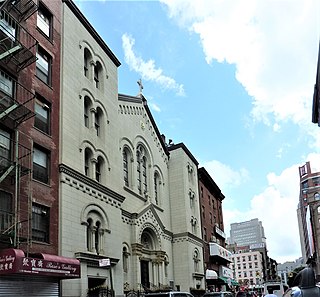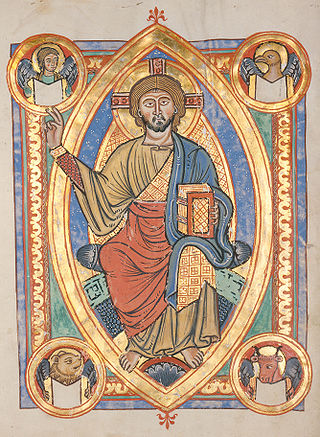The Most Precious Blood refers to the Eucharist, a Christian rite.
Most Precious Blood can also refer to:

The Eucharist, also known as Holy Communion, Blessed Sacrament and the Lord's Supper, is a Christian rite that is considered a sacrament in most churches, and as an ordinance in others. Christians believe that the rite was instituted by Jesus at the Last Supper, the night before his crucifixion, giving his disciples bread and wine. Passages in the New Testament state that he commanded them to "do this in memory of me" while referring to the bread as "my body" and the cup of wine as "the blood of my covenant, which is poured out for many". According to the Synoptic Gospels this was at a Passover meal.

Transubstantiation is, according to the teaching of the Catholic Church, "the change of the whole substance of bread into the substance of the Body of Christ and of the whole substance of wine into the substance of the Blood of Christ". This change is brought about in the eucharistic prayer through the efficacy of the word of Christ and by the action of the Holy Spirit. However, "the outward characteristics of bread and wine, that is the 'eucharistic species', remain unaltered". In this teaching, the notions of "substance" and "transubstantiation" are not linked with any particular theory of metaphysics.

The epiclesis refers to the invocation of one or several gods. In ancient Greek religion, the epiclesis was the epithet used as the surname given to a deity in religious contexts. The term was borrowed into the Christian tradition, where it designates the part of the Anaphora by which the priest invokes the Holy Spirit upon the Eucharistic bread and wine in some Christian churches. In most Eastern Christian traditions, the Epiclesis comes after the Anamnesis ; in the Western Rite it usually precedes. In the historic practice of the Western Christian Churches, the consecration is effected at the Words of Institution though during the rise of the Liturgical Movement, many denominations introduced an explicit epiclesis in their liturgies.

A monstrance, also known as an ostensorium, is a vessel used in Roman Catholic, Old Catholic, High Church Lutheran and Anglican churches for the display on an altar of some object of piety, such as the consecrated Eucharistic Sacramental bread (host) during Eucharistic adoration or during the Benediction of the Blessed Sacrament. A monstrance may also serve as a reliquary for the public display of relics of some saints. The word monstrance comes from the Latin word monstrare, while the word ostensorium comes from the Latin word ostendere. Either term, each expressing the concept of "showing", can refer to a vessel intended for the exposition of the Blessed Sacrament, but ostensorium has only this meaning.

The Fátima prayers are a collection of seven Catholic prayers associated with the 1917 Marian apparitions at Fátima, Portugal. Of the seven prayers, reportedly, the first two were taught to the three child visionaries by the Angel of Peace, the next three were taught to the children by Our Lady of Fátima herself during the course of the apparitions, and the final two were taught to Lúcia de Jesus Rosa dos Santos, the eldest and last survivor of the three, in 1931 by Jesus Christ when she was already a nun. Of the seven prayers, the rosary decade prayer is the best-known and the most widely recited. For each prayer below, an English translation is given alongside the Portuguese original.

The Missionaries of the Precious Blood is a Catholic community of priests and brothers. The society was founded by Saint Gaspar del Bufalo in 1815.
A sacrament is a Christian rite, including:
The Prayer of Humble Access is the name traditionally given to a prayer originally from early Anglican Books of Common Prayer and contained in many Anglican, Methodist, Presbyterian, and other Christian eucharistic liturgies, including use by the personal ordinariates for former Anglican groups reconciled to the Catholic Church. Its origins lie in the healing the centurion's servant as recounted in two of the Gospels. It is comparable to the "Domine, non sum dignus" used in the Catholic Mass.

Blood of Christ, also known as the Most Precious Blood, in Christian theology refers to the physical blood actually shed by Jesus Christ primarily on the Cross, and the salvation which Christianity teaches was accomplished thereby, or the sacramental blood (wine) present in the Eucharist or Lord's Supper, which some Christian denominations believe to be the same blood of Christ shed on the Cross.

Eucharist is the name that Catholics give to the sacrament by which, according to their belief, the body and blood of Christ are present in the bread and wine that are consecrated during the Catholic eucharistic liturgy, generally known as the Mass. The definition of the Eucharist in the 1983 Code of Canon Law as the sacrament where Christ himself "is contained, offered, and received" points to the three aspects of the Eucharist according to Catholic theology: the real presence of Christ in the Eucharist, Holy Communion, and the holy sacrifice of the Mass.
Body and Blood of Christ may refer to:
Church of the Resurrection or Holy Resurrection Church may refer to:

The Church of the Most Precious Blood is a Roman Catholic parish located in New York City. The parish is under the authority of the Archdiocese of New York, and is the National Shrine Church of San Gennaro. Located at 113 Baxter Street with an additional entrance on Mulberry Street, the Church of the Most Precious Blood is part of Manhattan's Little Italy neighborhood. The Most Precious Blood parished merged with Old St. Patrick's Cathedral parish, and the two churches share priests and administrative staff.

Thanksgiving after Communion is a spiritual practice among Christians who believe in the Real Presence of Jesus Christ in the Communion bread, maintaining themselves in prayer for some time to thank God and especially listening in their hearts for guidance from their Divine guest. This practice was and is highly recommended by saints, theologians, and Doctors of the Church.

The Feast of the Most Precious Blood of Our Lord Jesus Christ was in the General Roman Calendar from 1849 to 1969. It was focused on the Blood of Christ and its salvific nature.

The Roman Catholic tradition includes a number of devotions to Jesus Christ. Like all Catholic devotions, these prayer forms are not part of the official public liturgy of the Church but are based on the popular spiritual practices of Roman Catholics. Many are officially approved by the Holy See as suitable for spiritual growth but not necessary for salvation.

The Scapular of the Most Precious Blood is a Roman Catholic devotional scapular. It is associated with the Archconfraternity of the Most Precious Blood.
Precious Blood Catholic Church may refer to:
Sisters of the Precious Blood may refer to:
The Litany of the Most Precious Blood of Jesus is a litany of the Roman Catholic Church, usually prayed in devotion to the Eucharist. The Litany was drawn up by the Sacred Congregation of Rites and promulgated by Pope John XXIII on February 24, 1960.